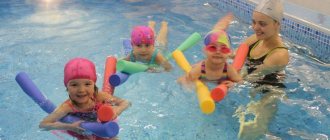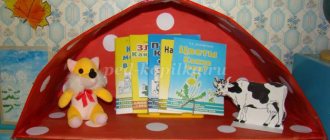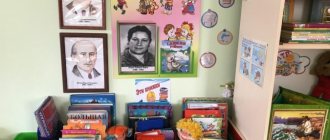Work in the music corner of a kindergarten
The activities of students in the music corner are carried out in joint classes with the teacher - individual or in a subgroup, and in independent form. The teacher works with the children in the corner as directed by the music director: with whom to work on dance skills, with whom to repeat the song, when to consolidate the learned material.
But more often, children independently become active in playing music and dancing. The teacher thinks through and designs the music corner so that it is in demand by the children, and plays a minor role in organizing independent games. Surprise moments help stimulate interest in activities in the corner (“A package of dance caps was delivered to our corner!”, “Today is Sveta’s doll’s name day, let’s arrange a small concert in honor of the holiday!”, “Yesterday I learned the rules of the musical lotto and I want to tell you about them!”), preliminary study of visual materials and listening to audio recordings.
Activities in the music corner
- Outdoor games. Conducted with mandatory musical accompaniment. The leader in outdoor games with primary and secondary preschoolers is the teacher; older children choose the leader themselves. An example of a game for kids: “Carousel”. The teacher puts on a belt with wide ribbons hanging, stands in a circle of children, and the kids take hold of the ribbons. Music sounds, children move in one direction to the music, twirl ribbons around the teacher, and change direction on command. An outdoor game for older preschoolers - “Pilots”: the leader gives a command, the children carry out (“Pilots, start the engine!” - make rotational movements with their arms, “Let’s take off!” - spread their arms to the side, begin to move, “Let’s land!” - slow down , stop), each landing involves the inclusion of excerpts of national songs on the player, children must move to the beat.
- Dance improvisations. Children perform dance moves to the music. Seasonal dance improvisations are carried out with appropriate attributes: in autumn - with artificial branches, in winter - with paper snowflakes, in spring and summer - with flowers and wreaths. For improvisations with elements of national dances, tambourines (tarantella), castanets (Mediterranean dances), handkerchiefs and wooden spoons (Russian folk dances), maracas (Latin American motifs) are used.
- Musical improvisations. Usually children include them in role-playing games: “Orchestra”, “Festive Concert”. For musical improvisations of older preschoolers, a leader is selected - a conductor; the roles of musicians are distributed among the other participants in the game - violinist, drummer, flutist, accordionist, etc. The “conductor” gives the command when to join the game for each of the “musicians” and when to stop performing.
- Didactic games. With younger pupils, the teacher conducts games to recognize the sound of instruments (plays an instrument behind a screen or turns on an audio recording, and the children name the instrument), to determine the nature of the music (children show pictures of an emotional state or a symbol for the sounding melody: sad, calm, cheerful), to reproduce a sound pattern (children are asked to show with their voice the depicted pattern: a line with bends - the melody is smooth, the line gradually tends downwards - a transition from a loud sound to a quiet sound, etc.). For older children, games are suitable for identifying the strong beat in a musical passage (they show the strong place on the card), for guessing familiar musical compositions (the game “Flower of Seven Flowers”: on each petal there is an illustration of a work whose name you need to remember) and composers (the game “Records”: having guessed the name of the composer whose work is heard, children stick a card with a portrait of the author onto the record).
- Dramatization games. The dramatization of fairy tale plots familiar to children involves the emotional disclosure of characters in accordance with the music playing. Musical games-dramatization in kindergarten: “The Fox and the Hare”, “Teremok”, “Zayushkina’s Hut”, “Turnip”, “Kolobok”, “Gray Neck”.
MAGAZINE Preschooler.RF
Implementation of the Federal State Educational Standard in a kindergarten Recommendation for teachers of preschool institutions“Creation of a creative musical zone in the light of fulfilling the requirements of the Federal State Educational Standard”
EDUCATION LAW: Article 48. Teaching staff are obliged to: develop students' cognitive activity, independence, initiative, and creative abilities.
FEDERAL STATE EDUCATIONAL STANDARD OF PRESCHOOL EDUCATION:
I. GENERAL PROVISIONS:
2.4. The program is aimed at:
creating conditions for the child’s development that open up opportunities for his positive socialization, his personal development, the development of initiative and creative abilities based on cooperation with adults and peers and age-appropriate activities; to create a developing educational environment, which is a system of conditions for the socialization and individualization of children.
II. REQUIREMENTS FOR THE STRUCTURE OF THE EDUCATIONAL PROGRAM OF PRESCHOOL EDUCATION AND ITS SCOPE:
2.6 Program content:
Artistic and aesthetic development presupposes the development of prerequisites for the value-semantic perception and understanding of works of art (verbal, musical, visual), the natural world; the formation of an aesthetic attitude towards the surrounding world; formation of elementary ideas about types of art; perception of music, fiction, folklore; stimulating empathy for characters in works of art; implementation of independent creative activities of children (visual, constructive-model, musical, etc.).
Recommendations:
Creating a creative zone in a group is necessary for the development of the musical and creative abilities of a preschooler. This is an integral part of the entire pedagogical process, which is very important for nurturing aesthetic, cultural and moral qualities in a child, as well as for identifying and developing his creative and musical abilities.
Where to start creating such a creative zone?
I Study the recommendations for teachers on organizing and designing a music corner in a group.
II Together with the music director, select equipment
by sections that correspond to this age group:
2.1. Listening:
-Purchase portraits of famous Russian and foreign (including modern composers (M. Glinka, P. Tchaikovsky, D. Kabalevsky, A. Mozart, L. Beethoven, I. Bach, Krasev); -Replenish the music library on listening and perceiving music ( classical, children's, thematic and modern musical works) -Purchase DVDs with educational information about art -Select illustrations of musical instruments, sheet music, pictures of animals singing, dancing or playing musical instruments.
2.2.Playing children's musical instruments:
-Fake musical instruments - toys (made by teachers, together with children) - these are not voiced flat musical instruments made of thick cardboard or thin plywood, which are needed to create a play situation in which children, fantasizing, imagine themselves as musicians (piano, accordion , balalaika); — Material for creative role-playing games are soft toys, soft musical toys, tumbler dolls, figurative musical singing or dancing toys (dog, cat, cockerel, bunny); -Children's musical toys and instruments for creative music-making: children's piano, accordion, a metallophone is added from the middle group; -Sounded toys: (musical hammer, barrel organs, guitars, rattles, musical tops) Children examine them, try to extract individual sounds or a fixed melody from them; -Noise instruments: tambourines, rattles, drums, maracas, small and large bells, bells, spoons.
2.3 Singing and singing along:
-Keep a notebook for recording songs, poems, nursery rhymes learned in music classes; — Purchase audio recordings of the pros and cons of the song material being learned.
2.4 Didactic games:
- “Sun or rain” (for distinguishing the nature of music - “Quiet-loud” (for distinguishing dynamics) - “Guess what I’m playing” (for the development of timbre and pitch hearing) - “Rhythmic nesting dolls” (for the development of rhythmic hearing)
III Create a folder with theoretical material:
3.1 Consultations for educators: 3.2 Consultations for parents: 3.3 Scenarios for musical matinees held in a group.
When designing a musical and creative area, you need to remember the age and individual capabilities of children. So, for children 3-5 years old, it is better to build the design on a plot basis, and for older children - on a didactic basis. The musical object environment must correspond to the eye, the actions of the hand, and the growth of the child. The music corner should have a cabinet, shelves for musical aids, a table, and chairs for educational games. The aids of the developing environment are of good quality, aesthetically pleasing, attractive, easy to use, and evoke a desire to act with them. There should be carpets and soft ottomans on the floor. This creates comfort and promotes concentration. It is better to put a DVD player in the corner, with which children can listen to music, various cartoons, as well as melodies that promote psychological relaxation and mental relaxation. Usually, stands are hung on the walls of the music corner. Lyrics of songs, poems, ditties, photographs of children's performances, composers, colorful posters, pictures of musical instruments are attached to them. The music corner can be designed very interestingly and brightly - in the form of a stage podium, on the steps of which the necessary aids for musical education are located, also in the form of a pyramid, in younger groups - on various characters sewn from fabric, these can be Parsley, a matryoshka doll, a snowman. A creatively designed music corner will not only help you plunge into the world of music and expand your understanding of it, but will also develop children’s imagination, activate the emotional sphere, thinking, and speech. The music corner can be designed together with other corners, for example, with speech or educational ones. An interesting design option is to combine music and theater areas. I propose to place the following types of theaters in the music corner: 1. Picture theater (Flannelograph). (How to make) Cut out fairy tale characters from cardboard, and glue pieces of flannel on the back side; such figures will stick perfectly to plywood covered with flannel. With the help of visual accompaniment of pictures and toys, children learn to follow the actions of characters in short poems, nursery rhymes, and fairy tales. 2. Finger theater (a doll can be made from cut-off gloves, eyes, ears, and pigtails can be attached). Games with finger puppets will help your child learn to control the movements of his own fingers. 3. Table theater (Russian folk tales) In order for children to constantly maintain interest in independent musical activities, it is necessary to update the manuals in the music and theater area 1-2 times a month and introduce new equipment.
| Next > |
Consultation for teachers “Music Corner”
Music corners should contain:
- Neo-sounding musical instruments;
- O sonorous musical instruments;
- Musical toys;
- Homemade musical instruments;
- Musical and didactic games;
- Technical means (audio and video recordings).
The corner is updated 1-2 times a quarter!
- introduce new musical and didactic games,
- new equipment and homemade musical instruments.
“Musical corner of the 21st century” or “Modern trends”
The group must have audio and video equipment, CD and DVD players, headphones (for older preschool age), so that one child does not disturb others while listening to music.
A selection of children's contemporary songs and classical music in accordance with the age category of children.
High-quality sound of musical instruments (including electronic ones), i.e. well-tuned and producing sounds familiar to children (so as not to pollute the child’s auditory experience).
Answer the questions:
- What is the main purpose of the music corner:
- teach musical literacy
- develop creativity
- cultivate aesthetic taste
- strengthen the physical and mental development of the child?
- What levels is the music corner divided into and why?
- How many times are manuals and materials updated per year?
- What do modern trends require?
Musical corners in groups.
List of materials for children from 2.5 to 4 years old
(1st and 2nd junior groups):
- tumbler dolls;
- figurative musical “singing” or “dancing” toys (cockerel, cat, bunny, etc.);
- toys-instruments with a fixed sound - organs, organs;
- toys-instruments with a sound of indefinite pitch: rattles, bells, tambourine, drum;
- a set of unvoiced figurative instruments (accordions, pipes, balalaikas, etc.);
- attributes for musical outdoor games;
- flags, plumes, scarves, bright ribbons with rings, rattles, autumn leaves, snowflakes, etc. for children's dance creativity (by season);
- table screen with glove toys;
- tape recorder and a set of software audio recordings;
- singing and moving toys;
- musical pictures for songs, which can be made on a cube and in the form of a large album or individual colorful illustrations.
List of materials for children 4-5 years old
(middle group of kindergarten):
In the music area for independent activities of children 4-5 years old, it is advisable to have:
- glockenspiel;
- noise instruments for children's orchestra;
- little books “We Sing” (they contain bright illustrations of familiar songs);
- flannelograph or magnetic board;
- musical and didactic games: “Three Bears”, “Recognize and Name”, “In the Forest”, “Our Orchestra”, “Seven-Flower Flower”, “Guess the Bell”, etc.;
- attributes for outdoor musical games: “Cat and Kittens”, “Hen and Cockerel”. “Hares and the Bear”, “Pilots”, etc.
- musical ladders (three-step and five-step, on which there are small and large birds or a small and large nesting doll;
- ribbons, colored scarves, bright plumes, etc. (attributes for dance improvisations, but for the season;
- table screen and a set of toys;
- musical toys (sounding and noise) for creative music making:
- tape recorder and a set of software audio recordings.
List of materials for children 5-6 years old
(senior kindergarten group):
In addition to the middle group materials, the following is used:
- rattles, tambourines, drums, triangles, etc.
- musical toys-instruments with diatonic and chromatic sound (metallophone, piano, button accordion, accordion, flute);
- illustrations on the theme “Seasons”;
- homemade musical toys (noise orchestra);
- portraits of composers;
- illustrations from the “Musical ABC Book”;
- musical and didactic games: “Bee”. “Musical Lotto”, “Recognize and Name”, “Steps”, “Repeat the Sounds”, “The Three Little Pigs”, “Magic Top”, “Musical Train”, “Guess What Sounds”, etc.
- attributes for outdoor games (“Round Dance in the Forest”, “Raven”, “Cat and Mice”, etc.);
- children's drawings for songs and familiar pieces of music;
- screens: tabletop and screen according to children’s height;
- three-, five- and seven-step musical stairs - voiced;
- attributes for children's dance creativity: elements of costumes for familiar folk dances;
- multi-colored feathers, multi-colored gloves for musical improvisations behind a screen and other attributes;
- attributes for dance improvisations according to the season - leaves, snowflakes, flowers, etc.):
- a tape recorder and a set of software audio recordings or disks.
List of materials for children 6-7 years old
(preparatory group of kindergarten):
- musical instruments (maracas, tambourines, harp, children's piano, metallophone, bells, triangles, flutes, drums, etc.);
- portraits of composers;
- illustrations on the theme “Seasons”;
- pictures for the manual “Musical ABC Book”;
- albums: “We draw a song” or “We draw and sing” with children’s drawings, in which they reflect their emotions and feelings about the pieces of music they listened to and their favorite songs;
- graphic aid “Emotions” (cards depicting faces with different emotional moods) to determine the nature of the melody when listening to works;
- albums for viewing: “Symphony Orchestra”, “Folk Instruments”, “Dances of the Peoples of the World”, etc.;
- musical stairs (three-, five- and seven-step - voiced);
- a set of homemade instruments for a noise orchestra;
- musical and didactic games: “Three Little Pigs”, “Three Flowers”, “Musical Umbrella”, “Ri”, “Rhythmic Cubes”, “Name the Composer”, “Funny Record”, “Musical Chicks”, etc.;
- attributes for outdoor games (for example, “Hello, autumn”, “Cosmonauts”, etc.);
- attributes for children's dance creativity, costume elements for familiar folk dances (kerchiefs, wreaths, hats) and attributes for dance improvisations according to the season (leaves, snowflakes, flowers, etc.); multi-colored gloves, plumes, gauze or scarves, multi-colored ribbons, multi-colored feathers for music and dance improvisations; tape recorder and a set of software audio recordings or disks »
CONSULTATION FOR TEACHERS
TOPIC: ROLE OF THE TEACHER IN MUSICAL CLASSES AND HOLIDAYS
Among the many recent problems related to preschool education, the problem of interaction between educators and specialists stands out. And the problem of pedagogical interaction between the teacher and the music director is one of the most important: the success of the process of not only musical, but also the general aesthetic development of preschool children depends on its solution.
We, music directors, would like to see the interest of teachers in the process of music lessons. When a child sees that the teacher completes all the tasks with interest, he becomes involved in the process with even greater inspiration. After all, the teacher is an absolute authority for him, and no matter what happens in class, the child will constantly focus on the teacher.
How does a teacher’s interest in a music lesson show? First of all, the teacher needs to understand that in a music lesson he is as much a participant as the children, and not an overseer. Imagine that you are a child, everything is interesting to you and you and your children cheerfully sing songs, dance fervently, listen to music thoughtfully... And you do this not as a duty, but with your soul, but do not forget that there is a pedagogical process that needs to be controlled.
And now let’s move on from aesthetics to organizational issues.
SO:
1. During a music lesson, children should be smartly dressed,
wear comfortable shoes, girls must wear skirts.
2. starting from the middle group of children, it is necessary to build, alternating
boy and girl.
3.You should arrive to class 2-3 minutes before the start so that
line up and get the children ready for the activity.
4. The teacher brings with him a notebook with a hard cover on
spirals and pen to write down words of songs, games, movements
dances, recommendations, etc.
5. During class, it is advisable not to leave the hall, so as not to
skip some material.
6.Do exercises with the children. Movements of dances, games,
sing songs, etc.
7.Monitor the children’s movements correctly
8.Before class, it is necessary to maintain musical silence: do not
turn on the tape recorder, since children have hearing loss
perception and concentration
9. In free activity, consolidate the material received in class.
Nitophone, audio materials.




